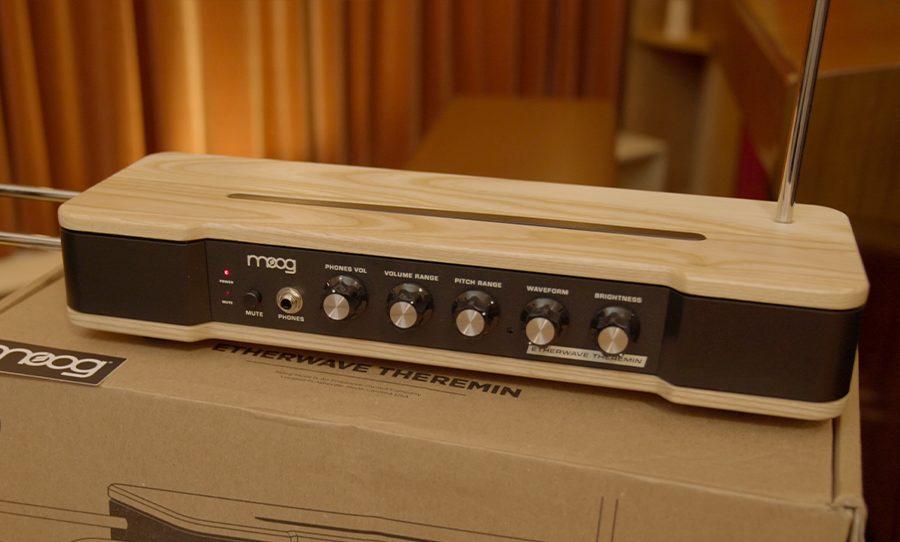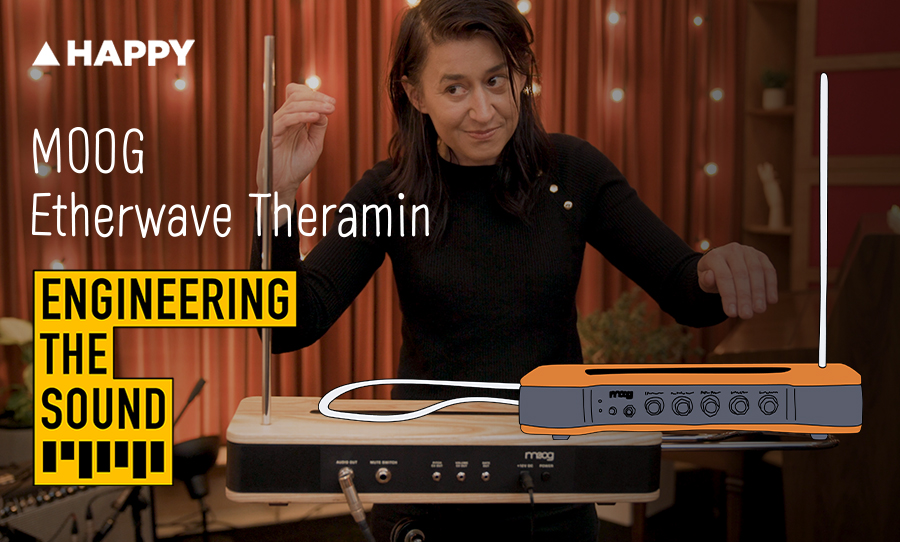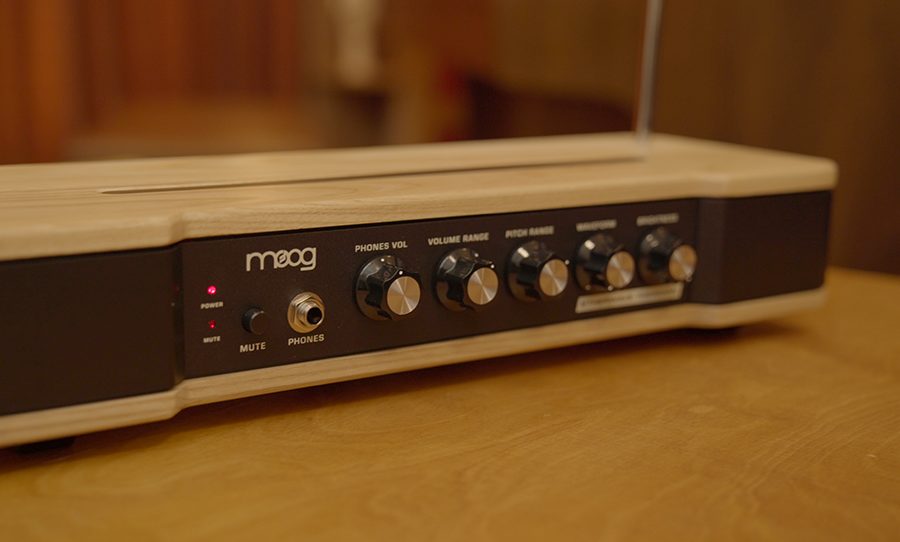ICYMI, Moog released the Moog Etherwave Theremin earlier this year. It’s the latest evolution of this mysterious and legendary instrument.
Celebrated synthesizer company Moog (rhymes with vogue) dances on the line of classic-yet-inventive and their update of the Theremin breathes new life into an instrument that still raises eyebrows of intrigue.
Whether you’re entering the Theremin field for the first time or are at a virtuoso level, this is a great piece of gear. Based on Bob Moog’s original circuit and design, it’s an affordable and professional instrument with an iconic Theremin sound. We dove into the new Moog Etherwave Theremin in the studio. Read on and watch our video below:
Unlike many entry-level Theremins, this is not a toy and provides you with the tools to tune it accurately and perform authentically. If you’re like me, the Theremin is an intriguing but yet-to-be-explored instrument.
With improved precision, playability and portability this new release is a good-looking piece of kit. How can you go wrong with the combination of a hand finish hardwood casing, silver hardware, black interface and those classic Moog knobs?
This iteration of the Etherwave is based on the circuit design that Bob Moog started when he built is first Theremin at age 14 and completed at 70. It features updated analog electronics for improved bass response along with an accurate 5 octave pitch range and balanced spacing between notes.
The inclusion of CV outs adds the ability to translate the unique Theremin performance style to other modular and semi-modular synths for some crazy new possibilities.
Where was this spooky instrument born?
Sometime around 1920, Leon Theremin was devising a system to detect motion — or gas density…it’s somewhat unclear — using radio waves when he noticed that moving his hands near the device made it omit an unusual sound.
Leon, a trained cellist, quickly realised there was potential for a much more exciting invention with his new-fangled technology so followed the tangent to eventually patent his invention as the Etherphone in 1928. Making it one of the first electronic music instruments.
Although Leon wowed audiences across the world with his futuristic, cello-meets-human-voice-meets-science fiction sound box, it didn’t initially take off — but nor did the Pedal Steel. It was hampered by the tough political and economical time it was born into, but the biggest issue was that the Theremin is very hard to play.
We have Lithuanian violin prodigy, Clara Rockmore to thank for overcoming that. As Clara suffered from tendonitis in her bow hand she made the switch to this highly ergonomic instrument and was the first performer to bring a level of musical artistry to the Theremin.
After releasing her album The Art of Theremin in 1977, she toured the world with this instrument, turning heads and making waves (pun intended!). Hollywood also provided a source of momentum when the Theremin was lapped up by film composers for the eerie, spooky and mystical quality of its sound.
From there this musical alien invaded the mainstream landing in several hits: Good Vibrations by The Beach Boys, Please Go Home by The Rolling Stones, Velouria by The Pixies and Great Gig in the Sky by Pink Floyd.
These days you can find the Theremin in all sorts of hacky forms, from homemade circuits, DIY kits and kids toys. However, As I found with the $20 Theremin kit I once bought of Ebay it’s a stretch to call many them a musical instrument.
The Moog Etherwave Theremin however is one of the most popular legit Theremins on the market, thanks its rich sound, solid construction, and ability to control pitch and sensitivity.

So how does this retro-space age thingamajig actually work?
The Moog Etherwave Theremin’s antenna generates an electromagnetic field and basically becomes half of a capacitor. The antenna acts as one plate of the capacitor and the other plate is your hand. As your hand enters the electromagnetic field of the antenna it gives the current something to bounce off and just like that we have an oscillator.
As you move your right hand back and forth or up and down the rate of oscillation changes. The oscillator is sent through the box where some magic called the heterodyne principal occurs before it gets amplified. The left hand controls the volume by moving up and down above the loop antenna on the left side.
The front panel has 5 big Moog knobs and a mute switch, on the back there’s an audio out, mute footswitch input, and CV outputs that allow you to control pitch, volume and gate of other synths or CV units. On the bottom you’ll find a quick release mic stand adaptor.
Set up is simple as the pitch antenna slides into the top hole and the volume bar slides into the side. Then its out from the rear audio jack into a DI or even a guitar amp or straight into the front headphone jack with your favourite headphones. The mute function will only affect the audio out signal so you can preview your pitch in the headphones.
From the left we have Headphone volume followed by the Volume range — this sets speed of the volume range. Turning the knob counter clockwise from a 12 o’clock position will give a slower, smoother dynamic, and clockwise will change the volume faster for a more staccato style. Setting the volume range is about personal choice and provides some flexibility in the style of music you’re performing.
How do you setup the Moog Etherwave Theremin?
The pitch range knob is for tuning your Theremin to your body. Every player needs to tune-up as your entire body is part of the instrument and will affect how the electro-magnetic field responds.
Tune the oscillator by starting at 12 o’clock and turn the knob fully counter clockwise. This will produce a high pitched sound. Now slowly turn the dial clockwise until you hit a note an octave below middle C (get out your smart phone tuner or send the headphone jack to a pedal tuner). Step back from the Theremin and the pitch will continue to decrease until it stops completely. This is called zero-beat or 0 Hz.
Now take your position at the Theremin with your right shoulder about 60cm from the Pitch Antenna and your arm by your side. Tune the oscillator so it is more than two octaves below middle C. And you’re all tuned up.
Can you be a Theraminist?
The Theremin is the only instrument that is played with touching it. You may have noticed great Theraminists always have an intense, stoic look about them. This isn’t some kind of Theremin-poser-rock move but an important part of an accomplished performance. Playing the Theremin requires an almost meditative state where the player has complete control and awareness of their body movements.
As the current is always running, silences and rests must also be played by lowering the hand all the way down on the loop antenna on the left side.
The right hand does all the pitch work. As you move your hand closer to the antenna the pitch goes up. Unlike a stringed instrument where frets and intervals get smaller as the pitch gets higher, the Theremin’s intervals remain the same.
A Thereminist will use hand positions to help with accuracy by touching the index finder to the thumb and cycling through extended finger positions and back to a clenched fist to locate notes on a scale.
Clara Rockmore described these positions as “butterfly wings” with the left hand moving in a hovering motion to gently guide the volume, creating purposeful accents and evolving cresendos, while the right hand dances with precise movements to play a melody. Finding the notes of a melody is completely different to every other instrument in western music.
With no hint of a fret, button or key to show you where a note might be, it’s all down to your well trained ears to find a note and move between intervals. Sounds hard? Well, it is, but it’s also a lot of fun and with practice master theremin players can rely on their muscle memory to draw magical sounds out of thin air.
The Theremin is a completely unique addition to your musical instrument collection that has the potential to unlock your inner musical mad scientist, and this new Moog Etherwave Theremin is a great update.
For more details head over to Moogmusic.com




